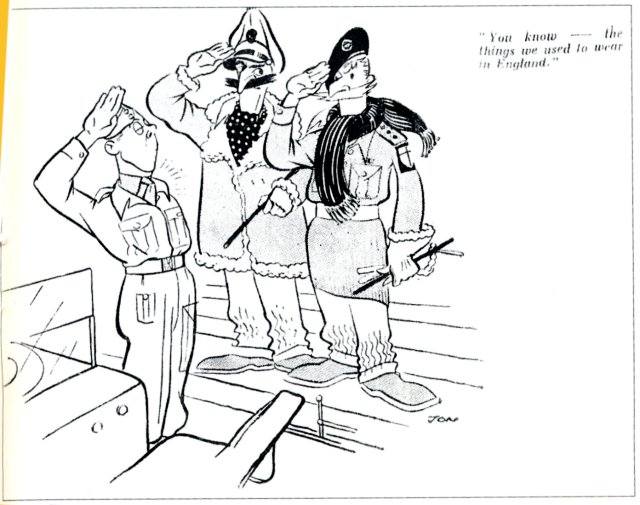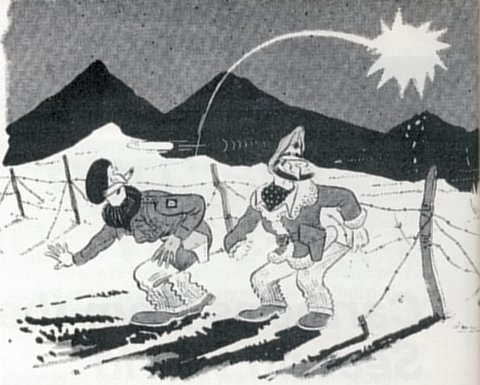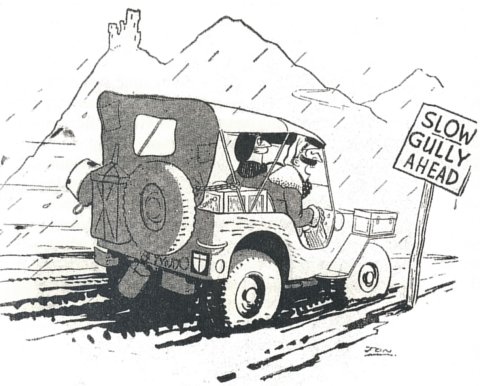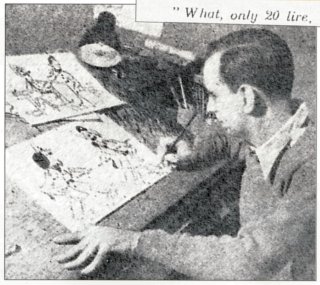

 The South African
The South African
The material presented in this short article comes from the publication, The 'Two Types' by Jon, British Army Newspaper Unit, CMF, 1944. The artist, John Philpin Jones, passed away in 1992, so the material is reproduced here in good faith in the interests of bringing the 'Two Types' out of obscurity.

"What, only 20 lire, old man!"
If you are interested in some of the oddities of war, look at the cartoons that have survived in repositories such as the Archives of the South African National Museum of Military History in Johannesburg. Over past issues, we have illustrated the back cover of this journal with many cartoons from the Museum's collection, covering various wars, many of which have stood the test of time very well. The greatest numberof surviving cartoons date from the Second World War (1939-1945) and some of these were drawn by artists who went on to great success, such as Ronald Searle of 'St Trinian's' fame.
Recently, a small, unpretentious paper-covered booklet was donated to me to give to the Museum's Archives. It was given to me by an elderly lady of my acquaintance, who had found it when she was clearing out her house prior to moving, but she had no idea how it had come to be there. What we can be sure of, is that there is a strong likelihood that the original owner, whoever he or she may have been, was a South African who served in Italy in 1944. The booklet was sold to the troops in that year at 20 lire a copy, proceeds going to the Army Welfare Services Fund 'for expenditure on special welfare objects'.
It was produced by the British Army Newspaper Unit, CMF (Central Mediterranean Force) 'for the fighting men of all ranks and Services in this theatre', and was 'distributed by the Army Welfare Services'. The wartime paper is yellow and frail now, the thin brown paper cover adorned with the only colour illustration. This depicts the 'Two Types' of the title, and identifies the artist simply as 'Jon'. The booklet contains 'the saga of the two jaunty heroes who have given us the best laugh since the campaign began'. The foreword is by the Editor-in-Chief, British Army Newspaper Unit, CMF, Hugh Cudlipp, who had been editor of the Sunday Pictorial. He introduces 'The Two Types' as having been with the troops 'from Alamein to Tunis, Tunis to Sicily and on to the North of Italy'. He mentions their sartorial eccentricities, resilience and affable nature, and their popularity with the troops in North Africa, Italy, Sicily, Southern France and Greece.
Editor Cyril James, in the text accompanying the cartoons, says 'they are as much a part of this war as the bulldozer, the Bailey bridge or the flying bomb' and reflects that, when the war is over, 'they will disappear into the anonymity of the well-brushed bowler hat and tightly rolled umbrella'. Undoubtedly then, they are very English! They are identified as the Fair Type, who has 'a look of pop-eyed astonishment at a world packed with surprises', and the Dark Type, 'who does most of the shouting and is faithful to the felt SD hat he bought in Burlington Arcade before he went overseas in 1940'.

"You know, the things we used to wear in England."
The first thing you notice about them is their clothes. In no way are they wearing standard Army Issue! James explains, 'Long before the Eighth Army came into official existence, the men of the Army of the Nile and of Western Desert Force had achieved a reputation for a certain eccentricity of dress. The reason for the appearance of suede boots, silk scarves, corduroy trousers, sheepskin coats and shaggy pullovers was never merely the desire to be different, or to assume the distinctive clothing that would mark the wearer as a desert soldier.' In fact, the reasons were purely practical, to help them cope with conditions not imagined by the designers of 'War Office Sealed patterns'. The silk scarf was worn to protect the nose and mouth from the choking, gritty dust; the suede boots with rubber soles were deemed sensible desert footwear; the corduroy trousers did not show the stains made by sand and were tough enough to survive the rugged conditions; and the sheepskin coats kept them warm during the bitterly cold desert winter nights. Extra flourishes and personal touches could be bought cheaply in Cairo, when the troops were on occasional leave.

"Careful, careful, old man, it'll mean sending to Cairo for a new pair."
Not even the great and good were immune to this style. Field Marshal Montgomery arrived in the desert wearing 'a conventional hat with a red band', but soon afterwards abandoned it in favour of an Australian slouch-hat that shaded his face and eyes, and, later, adopted a practical twin-badge tank beret, which became his trademark headgear ever after. It also did not take long before he was wearing practical corduroy trousers. The question of uniform did not matter so much when the job had to get done. Gunners, for example, were known to tend to their charges in boots and underpants - and sometimes - 'just boots!' Captured Italian uniforms added some special sartorial touches to desert wear, such as the red woollen hats favoured by New Zealanders.

" ... Gully? Gully? -- I suppose they DO mean Wadi?"
Many 'old soldiers' from the Western Desert remained faithful to their 'unofficial uniform' for the rest of their lives. The veterans of the Desert Campaign clung to their comfortable and well-worn practical garb in Italy, even though it was perhaps not quite so useful in the mud and rain of the Italian peninsula, and caused much amusement. They wore their desert outfits with pride.
The artist

The creator of the 'Two Types', John Philpin Jones, at work, 1944
(Photo: The 'Two Types' by Jon, CMF, 1944).
John Philpin Jones, born in Llandrindod Wells, Wales, in 1913 was 'Jon', the creator of the 'Two Types' cartoons. He studied at the Birmingham School of Art and then went into advertising. He also worked as a cartoonist on the Cardiff Western Mail before he joined up for war service shortly after the outbreak of the Second World War. Jones underwent training at Sandhurst OCTU, enlisting in the Coldstream Guards, for which he did not have the necessary private income of £500 a year, so was then commissioned into the Welch Regiment instead.
He became Assistant Military Landing Officer (ALMO) attached to a Canadian division and took part in the invasion of Sicily and, later, Salerno and Anzio. After the establishment of the Anzio beachhead, he was evacuated with shell-shock to North Africa. There he joined the British Army Newspaper Unit under Editor-in-Chief Cudlipp, his cartoons chronicling the Italian campaign. The experiences of a pair of battlehardened British officers, the 'Two Types', became the 'Page Two Smile' and the popularity of these cartoons earned him an MBE. However, the top brass, including Alexander and Montgomery, were not always amused! Between 1943 and 1946, Jones drew some 300 'Two Types' cartoons.
After the war, Jones continued to work as a cartoonist for many newspapers in the United Kingdom, but wound up at the London Daily Mail in the 1960s. He was one of the founder members of the British Cartoonist's Association, becoming Cartoonist of the Year in 1981. By then, he had drawn more than 15 000 cartoons for the newspaper. He died in Wales in 1992.
Sources:
The 'Two Types' by Jon (British Army Newspaper Unit, CMF, 1944).
Index of Cartoonists (British Cartoon Archive, University of Kent).
Return to Journal Index OR Society's Home page
South African Military History Society / scribe@samilitaryhistory.org